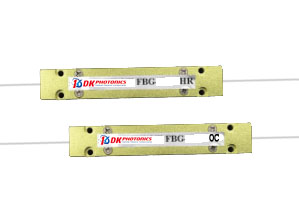China, 21th July, 2016: Optical passive components available at DK Photonics are significant in a number of industries such as telecommunication applications, fiber laser, etc. In order to better give our fiber laser customers to do matching service, DK Photonics work with a Chinese optical research institute, after more than half a year's efforts, and finally produced the FBG Mirrors used for fiber laser.
FBG Mirrors are based on the reflective properties of the Fiber Bragg Grating (FBG) written in the core of an optical fiber waveguide. FBG mirrors’ principal application is to use a high and low reflector to form a stable laser cavity having the lasing wavelength selected by the low reflector.
Fiber Bragg grating (FBG) is a distributed reflector constructed in an optical fiber short segment that allows reflecting particular wavelengths and transmitting the rest of them. The periodic variation of the fiber core refractive index generates a wavelength-specific dielectric mirror, which allows reflecting specific wavelengths. FBG can be used as a high reflector (HR) and output coupler (OC) to make a laser cavity in a fiber laser. Rare earth doped optical fiber increases the laser gain. The major advantage of all-fiber systems where free space mirrors are replaced with a pair of fiber Bragg gratings (FBG’s) is that the realignment process is no longer needed for the entire system functioning period, since FBG is spliced directly to the doped finer and never needs adjusting.
DK Photonics can provide varied wavelengths FBG, such as 1018nm, 1053nm, 1064nm, 1080nm, 1550nm, 1950nm, 2020nm, 2040nm; and can write in all common passive optical fibers, such as 6/125DCF,10/125DCF,15/130DCF,20/125DCF,25/250DCF,30/250DCF,20/400DC Fiber, PM or non-PM types are available. The Max. handling power up to 1000W. The following is main parameter or our FBG:
Parameters
|
Values
| |
Center Wavelength(nm)
|
1018nm, 1053nm, 1064nm, 1080nm, 1550nm, 1950nm, 2020nm, 2040nm
| |
Wavelength accuracy
|
0.2nm
| |
High Reector / Output Coupler
|
HR
|
OC
|
Reflectivity
|
≥99%
|
3%~20%
|
Bandwidth
|
1~3nm
|
0.2~1nm
|
Fiber Type
|
10/125 DCF,15/130DCF, 20/125 DCF,25/250 DCF,30/250 DCF,20/400 DC Fiber, PM or non-PM types are available
| |
Power Handling(core)
|
20W, 50W, 100W, 500W,1000W.
| |
Applications
FBGs offer multiple applications. It can replace conventional dielectric mirrors to provide optical feedback. It can be also used to create a multi-wavelength Raman fiber laser.
Fiber lasers offer a compact, electrically efficient alternative to Ar-Kr and Nd:YAG technologies. The FBG can be applied to fiber lasers of any type:
- Single frequency fiber lasers;
- Raman fiber laser;
- Fixed frequency visible wavelength lasers;
- Tunable frequency visible wavelength lasers;
- Ytterbium doped fiber lasers;
- Q-switched fiber lasers;
- Pulsed fiber lasers;
- Stabilized multi-mode emission sources;
- Fine optical fiber responder, etc.
To obtain more information about the products, visit http://www.dkphotonics.com/.
About DK Photonics
The DK Photonics claims that they even provide customized solutions to their patrons. Those industries who wish their products to be distinctive can contact them for the same. The team mentions that they have passed the ISO9001 quality tests and hence, there is no compromise in this aspect.

No comments:
Post a Comment